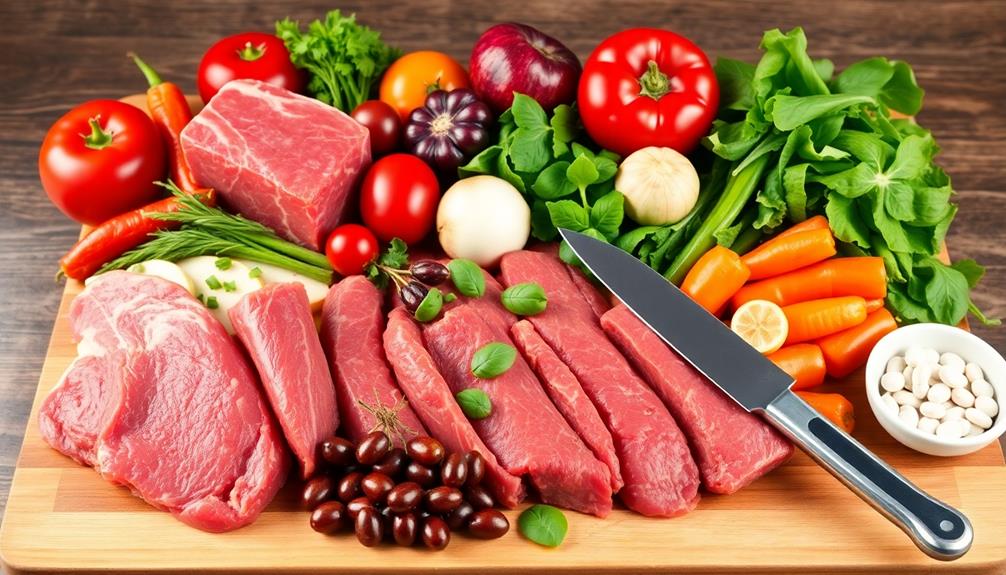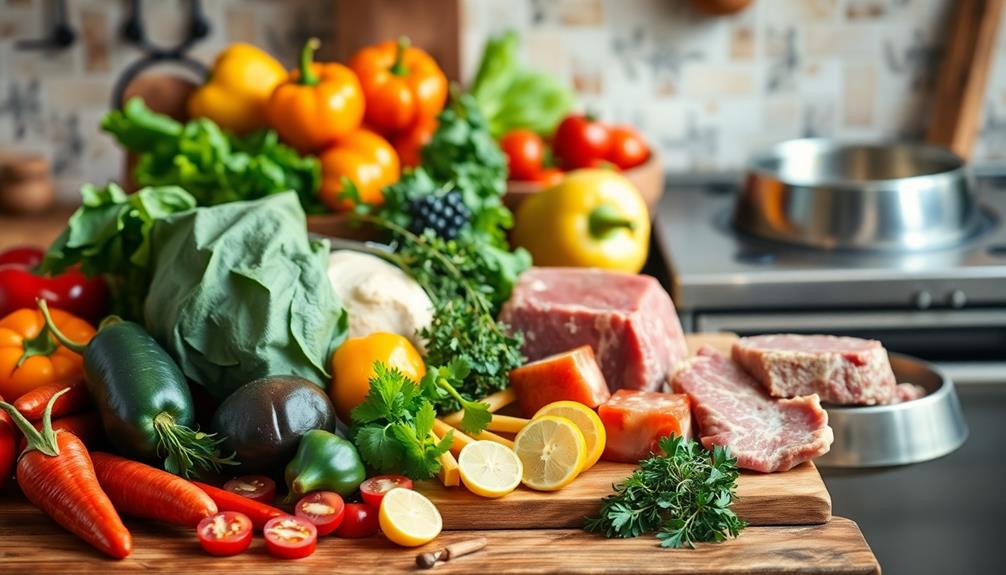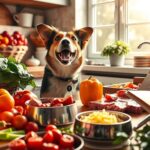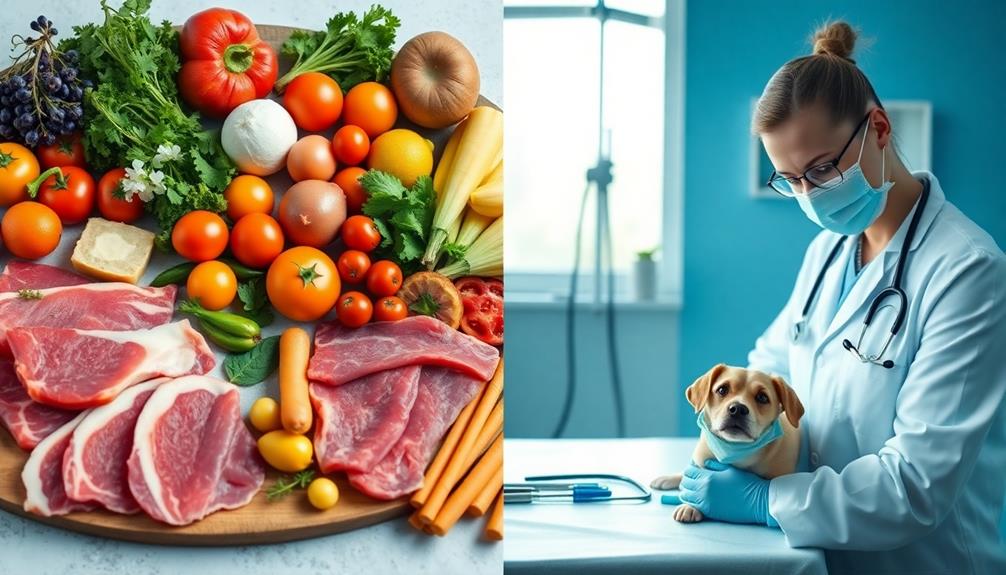Making raw pet food at home gives you control over ingredients and can save you up to 33% compared to store-bought options. Begin by focusing on a balanced diet for your dog, including 70% muscle meat, 10% organ meat, 10% raw edible bones, and 5% vegetables or fruits. Always practice safety by washing hands and utensils, and store food properly to prevent spoilage. Use reputable sources for your ingredients to guarantee quality. If you're ready to whip up tasty recipes tailored to your dog's needs, you'll find plenty of tips and guidelines ahead!
Key Takeaways
- Homemade raw pet food allows control over ingredient quality and ethical sourcing while potentially saving costs up to 33% compared to commercial options.
- A balanced raw diet should include 70% muscle meat, 10% organ meat, 10% raw edible bones, and 5% vegetables/fruits.
- Safety practices include washing hands, using separate utensils, and storing raw food in airtight containers to prevent spoilage.
- Regular monitoring of your dog's weight and health is crucial for ensuring nutritional balance and making necessary dietary adjustments.
- Transition to homemade raw food should be gradual to avoid digestive upset and ensure a smooth adaptation for your pet.
Benefits of Homemade Raw Food

Making homemade raw dog food offers a range of benefits that can greatly enhance both your pet's health and your lifestyle. By choosing a raw diet, you gain control over the quality ingredients used in your dog's meals. This means you can guarantee that the food is ethically sourced and tailored to meet your pet's specific nutritional needs. As a result, you'll likely see improvements in your dog's overall health, energy levels, and coat condition.
You might be surprised to learn that making your own dog food can save you up to 33% compared to commercial options. This not only helps you manage your budget effectively but also allows you to invest in high-quality, fresh, and natural ingredients that promote a balanced diet.
Additionally, preparing raw meals at home reduces packaging waste, contributing to environmental sustainability and promoting a healthier planet for us all.
Incorporating homemade dog food into your routine can lead to a happier, healthier pet while also aligning with your values of sustainability and quality. You'll feel satisfied knowing you're providing the best nutrition for your furry friend.
Nutritional Guidelines for Dogs

When crafting a raw diet for your dog, it's vital to adhere to specific nutritional guidelines to guarantee they receive balanced and complete nutrition. Dogs generally need about 2-3% of their body weight in food daily, but this can vary based on age, activity level, and health. For puppies, you'll want to increase feeding to around 5-6% of their body weight to support their growth.
A well-rounded raw diet should include:
| Component | Percentage |
|---|---|
| Muscle Meat | 70% |
| Organ Meat | 10% |
| Raw Edible Bones | 10% |
| Fresh Vegetables/Fruits | 5% |
Vital nutrients such as proteins, fats, vitamins, and minerals are important for your dog's health, while carbohydrates should be minimal. Keep a close eye on your dog's weight, adjusting portions as necessary to maintain a healthy body condition—ensure their ribs are slightly visible. By following these nutritional guidelines, you'll create homemade raw dog food that meets your dog's needs and keeps them healthy and vibrant.
Key Ingredients for Raw Diet

When creating a raw diet for your dog, it's vital to focus on essential nutrient ratios, ensuring a balanced mix of muscle meat, bones, organ meats, and veggies.
You also need to choose safe ingredients, steering clear of harmful foods while maximizing nutritional benefits.
Essential Nutrient Ratios
A balanced raw dog food diet typically consists of four key components: 70% muscle meat, 10% raw edible bones, 10% organ meats, and 5% fresh vegetables or fruits. This ratio guarantees your dog meets its nutritional needs while enjoying a variety of flavors.
It's important to select high-quality protein sources to support overall health, similar to the recommendations for best dog food for allergies.
Here are some essential points to take into account for ideal nutrient ratios:
- Muscle Meat (70%): Provides primary protein sources like chicken, beef, lamb, and fish.
- Raw Edible Bones (10%): Supply calcium and phosphorus, vital for bone health.
- Organ Meats (10%): Focus on liver, as it's rich in vitamins; don't exceed this percentage.
- Vegetables (5%): Enhance fiber and phytonutrient intake; safe options include carrots, spinach, and blueberries.
- Adjust for Body Weight: Feed 2-3% of your dog's body weight daily, factoring in activity level and health.
Safe Ingredient Selection
Selecting safe ingredients is fundamental for crafting a healthy raw diet for your dog. To start, focus on lean muscle meats like chicken, beef, and lamb, which should make up about 70% of the diet. Organ meats, such as liver and kidneys, are essential too, but limit them to 10% to avoid nutrient overload.
Next, include fresh vegetables like spinach and carrots, which provide vitamins and fiber. Always steer clear of harmful options, including onions and grapes.
Don't forget about omega-3 fatty acids! Incorporate fatty fish like salmon and sardines, but remember to freeze them beforehand to eliminate potential parasites. When sourcing raw ingredients, always choose reputable suppliers to minimize contamination risks.
Practicing proper hygiene during food preparation is crucial. Thoroughly clean surfaces and utensils after handling raw ingredients to prevent cross-contamination.
Supplementation for Balance
Supplementation plays an essential role in guaranteeing your dog's raw diet is nutritionally balanced. When you prepare homemade raw meals, it's fundamental to include key ingredients that provide essential vitamins and minerals.
Proper nutrition is critical for overall health, similar to how nutrition impacts child development and influences emotional well-being. Here are some important supplements to take into account:
- Zinc and iodine: Important minerals for immune function.
- Liver (organ meats): Should make up no more than 10% of the diet to prevent vitamin toxicity while offering essential nutrients.
- Omega fatty acids: Source them from oils like hemp or fish oil for healthy skin and coat.
- Medicinal herbs and dark berries: These enhance the diet with antioxidants and phytonutrients.
- Regular assessments: Monitor your dog's response to dietary changes to adjust supplementation as needed.
Incorporating these elements guarantees your dog receives a thorough range of nutrients.
Safety and Hygiene Practices

Maintaining safety and hygiene while preparing raw pet food is vital for both your health and your pet's well-being. Start by washing your hands thoroughly with soap and water before and after handling raw pet food. This helps prevent cross-contamination and the spread of harmful bacteria.
Use separate utensils, cutting boards, and preparation surfaces exclusively for raw pet food to minimize contamination risks. After preparing, make certain to clean and sanitize all surfaces and utensils with antibacterial soap or natural alternatives like vinegar. This step is important in maintaining hygiene practices.
When storing raw pet food, use airtight containers to keep the food fresh and reduce the risk of spoilage and bacterial growth. Refrigerate or freeze the food promptly to guarantee safety.
If you're handling raw meat, consider wearing rubber gloves to add an extra layer of protection against potential pathogens during preparation.
Essential Raw Dog Food Recipes

After guaranteeing proper safety and hygiene practices, you're ready to explore nutritious raw dog food recipes that cater to your pet's specific needs. Here are some essential recipes:
- Adult Dog Recipe: Combine 7kg of organic chicken or turkey, 1kg of beef or lamb tripe, 1kg of organ mix, 1kg of blitzed vegetables, and 10g of Canident supplement for balanced nutrition.
- Active Puppy Recipe: Use 4kg of organic chicken or turkey, 2kg of duck carcass mince, 2kg of fatty beef or lamb, 1kg of organ mix, and 6 organic eggs to guarantee higher calorie content for growth.
- Working Dog Recipe: Increase the proportion of duck and fatty meats while reducing chicken to meet your dog's energy needs.
- Overweight Dog Recipe: Focus solely on white meats and adjust portions based on calorie content, promoting healthy weight loss.
- Storage Tips: All raw dog food recipes should be blended, stored in convenient portions, and frozen to maintain freshness and guarantee safety during feeding.
These raw dog food recipes provide balanced nutrition tailored to your dog's unique requirements!
Portion Sizes and Feeding Tips

How do you determine the right portion sizes for your dog on a raw food diet? A general guideline is to feed adult dogs 2-3% of their body weight in raw food daily, while puppies need about 5-6% to support their growth.
| Dog Type | Portion Size (% of Body Weight) | Notes |
|---|---|---|
| Adult Dog | 2-3% | Adjust based on activity |
| Puppy | 5-6% | Essential for growth |
| Active Dog | 3% or more | Increased needs |
| Overweight | Lower than 2% | Monitor weight changes |
When switching to a raw diet, gradually mix old and new food to avoid digestive upset. You should also monitor weight changes regularly and adjust portion sizes to maintain a healthy body condition, ensuring your dog's ribs are easily noticeable. Utilizing a Dog Food Calculator can help you determine specific nutritional needs based on age, activity level, and health status. By following these feeding tips, you'll set your furry friend up for a successful raw food journey!
Monitoring Your Dog's Health

Monitoring your dog's health is essential when switching to a raw diet.
You'll want to keep an eye on their weight and look for signs of nutritional deficiencies to guarantee they're thriving.
Regular veterinary check-ups will also help you stay on top of their overall well-being and make any necessary dietary adjustments.
Weight Management Strategies
Maintaining your dog's ideal weight is essential for their overall health and longevity. Effective weight management involves regular monitoring and adjusting your dog's diet.
Here are some strategies to help you keep your furry friend in a healthy range:
- Monitor weight: Weigh your dog regularly to track any changes and address them promptly.
- Adjust feeding amounts: Aim for 2-3% of their body weight in food daily for adults, and 5-6% for puppies during their growth stages.
- Use a food calculator: Tailor your dog's feeding amounts based on their lifestyle, age, and health needs.
- Check for ribs: Confirm your dog's ribs are easily noticeable; this indicates a healthy weight.
- Schedule veterinary check-ups: Regular visits help evaluate your dog's health and the effectiveness of their raw feeding regimen.
Signs of Nutritional Deficiency
A healthy, vibrant dog is often a reflection of a well-balanced diet, making it important to recognize the signs of nutritional deficiency. To meet your dog's nutritional needs, regularly monitor your dog's weight; noticeable ribs indicate a healthy weight, while significant changes may reveal nutritional imbalances.
Pay attention to your dog's coat condition, too. A dull, flaky, or excessively shedding coat could signal deficiencies in essential fatty acids or other critical nutrients, similar to how a lack of safe fruits like apples may impact their health.
Energy levels are another key indicator. If your dog displays excessive lethargy or hyperactivity, it might suggest an imbalance in protein or carbohydrate intake. Additionally, tracking your dog's stool quality is essential. Consistently soft or unusually hard stools can indicate dietary issues, pointing to a need for reviewing fiber and nutrient balance in their raw diet.
Don't overlook behavior changes. Signs of irritability, lethargy, or unusual eating habits can be red flags for nutritional deficiencies that need immediate attention. By being vigilant about these signs, you can guarantee your dog thrives on a balanced raw diet, fostering their overall health and well-being.
Regular Veterinary Check-ups
Regular veterinary check-ups play an essential role in keeping your dog healthy and happy.
These visits help monitor your dog's overall health and catch potential issues early. As you prepare homemade raw diets, regular check-ups become even more important for ensuring nutritional adequacy.
Here are some key benefits of consistent vet visits:
- Weight Assessment: Tracking your dog's weight helps adjust food intake for a balanced raw diet.
- Nutritional Guidance: Vets can advise on meeting your dog's dietary needs based on age and activity level.
- Diagnostics: Blood tests can uncover deficiencies or imbalances in your dog's nutrition.
- Health Trends: Regular visits foster an understanding of your dog's health trends over time.
- Timely Adjustments: Early detection allows for necessary adjustments before issues escalate.
Ethical Sourcing of Ingredients

When sourcing ingredients for your pet's raw food, it's crucial to prioritize ethical practices that guarantee humane treatment of animals. Opt for meat from free-range, organic, and pasture-fed animals. These choices not only guarantee higher quality nutrition for your furry friend but also reflect your commitment to animal welfare.
Be cautious of misleading labels; terms like "natural" or "humanely raised" can often be vague and not truly indicative of ethical sourcing. Cheaper meat options typically come from intensive farming practices, which can compromise both the welfare of the animals and the quality of the meat.
To make a positive impact, research local producers and farmers' markets. By sourcing from these local farms, you support sustainable practices and promote humane treatment.
Additionally, consider incorporating by-products like organ meats and bones from these farms. This not only provides your pet with nutrient-rich food but also helps minimize waste.
Expert Advice and Resources

Maneuvering the world of raw pet food can feel overwhelming, but plenty of expert advice and resources are available to guide you. Dr. Conor Brady, a recognized dog nutritionist, offers invaluable insights through online consultations and educational materials tailored for raw feeding. Embracing these tools can lead to significant health improvements for your furry friend.
Here are some essential resources to take into account:
- Raw feeding articles to deepen your understanding of canine nutrition.
- Power paste recipes that guarantee your homemade diets are balanced and nutritious.
- Courses on dog behavior and nutrition for a well-rounded approach to pet care.
- Safety tips to help you navigate potential risks associated with raw diets.
- Regular veterinary check-ups to keep track of your dog's health and dietary needs.
The Dogs First platform is also a great resource, providing a support network for your questions and concerns.
Frequently Asked Questions
Is It Safe to Make Your Own Raw Dog Food?
Yes, it's safe to make your own raw dog food if you follow proper hygiene practices and guarantee a balanced diet. Regularly monitor your dog's health and consult a vet for personalized guidance.
How to Make Your Own Raw Dog Food at Home?
So, you want to make raw dog food at home? It's easy! Just blend muscle meat, bones, organ meats, and veggies. Remember to use fresh ingredients and keep everything clean—your pup's health depends on it!
How Do You Make Raw Food Safe?
To make raw food safe, you'll want to source high-quality ingredients, avoid cross-contamination, wash surfaces thoroughly, and consider freezing meat to kill parasites. Monitor health regularly to guarantee your pet's nutrition stays balanced.
How Do You Handle Raw Animal Food Safely?
Handling raw animal food safely's like steering through a minefield; one misstep can lead to disaster. Always wash your hands and surfaces, use separate cutting boards, and wear gloves to shield yourself from harmful bacteria.
Conclusion
By making raw pet food at home, you're not just giving your dog a nutritious meal, but also a chance to thrive. With proper safety practices and the right ingredients, you can create delicious recipes tailored to your pup's needs. So, why not take control of your dog's diet and watch them flourish? Remember, monitoring their health and sourcing ethically are key steps in this rewarding journey. Your furry friend deserves the best—let's give it to them!

















